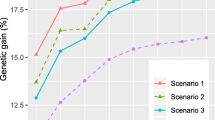Abstract
We evaluated a clone trial comprised of 20 ramets each of 40 Eucalyptus camaldulensis clones for growth and fertility at 4 years of age. The clones differed significantly in growth with 65–100 % survival in 38 clones while two clones had low survival (40 and 10 %). Fecundity was high and fertility variation low, as indicated by the sibling coefficient value (Ψ = 1.4) with 55 % of clones contributing 80 % of the fruits. Thinning strategies were considered to convert the clone trial to a clonal seed orchard and enhance both gain and diversity in seed crop. When clones were selected based on growth without considering fertility, truncation selection (to retain clones with higher DBH than the trial mean value) would give 8 % gain, but 59 % reduction in effective population size (N e ). Gain and predicted diversity (N e ) was highest when ramets were selected in linear proportion to the breeding value of each clone. Mass selection with the same intercept (for DBH) as truncation selection would give a moderate 3 % gain, but over two times higher predicted N e than truncation selection. When fertility of retained trees was considered after thinning, mass selection would yield 52 % effective contribution from the orchard trees compared to only 30 % contribution from truncation selection and linear thinning. Higher representation of superior clones in linear thinning and mass selection would lead to greater fertility variation and over 30 % reduction in effective clone number (N c ) from that predicted (N e , assuming equal fertility among ramets) before thinning.

Similar content being viewed by others
References
Bondesson FL, Lindgren D (1993) Optimal utilization of clones and genetic thinning of seed orchards. Silvae Genet 42:157–163
Doran JC, Pinyopusarerk K, Arnold R, Harwood CE (1996) Breeding Plan for Eucalyptus camaldulensisin Tamil Nadu. UNDP/FAO Regional Project on Improved Productivity of Man-Made Forests through Application of Technological Advances in Tree Breeding and Propagation. (RAS/91/004-FORTIP)
GIT Forestry (2008) Cultivated Eucalypts Global Map 2008. http://www.git-forestry.com/
Johnson R, Lipow S (2002) Compatibility of breeding for increased wood production and long term sustainability: the genetic variation of seed orchard seed and associated risks. In: Proceedings Wood compatibilityinitiative workshop, number 18:169–179. (cf- Lindgren & Prescher, 2005)
Kamalakannan R, Varghese M, Lindgren D (2007) Fertility variation and its implications on relatedness in seed crops in seedling seed orchards of Eucalyptus camaldulensis and E. tereticornis. Silvae Genet 56(6):253–259
Kang KS, Lindgren D (1999) Fertility variation among clones of Korean pine and its implications on seed orchard management. For Genet 6:191–200
Kang KS, Lindgren D, Mullin TJ (2001a) Prediction of genetic gain and gene diversity in seed orchards crops under alternative management strategies. Theor Appl Genet 103(6–7):1099–1107
Kang KS, Harju AM, Lindgren D, Nikkanen T, Almqvist C, Suh GU (2001b) Variation in effective number of clones in seed orchards. New For 21:17–33
Kang KS, Bila AD, Harju AM, Lindgren D (2003) Estimation of fertility variation in forest tree populations. Forestry 76(3):329–344
Lindgren D, Matheson AC (1986) An algorithm for increasing the genetic quality of seed from seed orchards by using the better clones in higher proportions. Silvae Genet 35(5–6):173–177
Lindgren D, Mullin T (1997) Balancing gain and relatedness in selection. Silvae Genet 46(2–3):124–129
Lindgren D, Prescher F (2005) Optimal clone number for seed orchards with tested clones. Silvae Genet 54(2):80–92
Lindgren D, Gea L, Jefferson P (1996) Loss of genetic diversity monitored by status number. Silvae Genet 45(1):52–59
Namkoong G (1981) Introduction to quantitative genetics in forestry. Castle House Publications, Kent
Olsson T, Lindgren D, Li B (2001) Balancing genetic gain and relatedness in seed orchards. Silvae Genet 50:222–227
Phillips A, Brown AHD (1977) Mating system and hybridity in Eucalyptus pauciflora. Aust J Biol Sci 30:337–344
Potts BM, Potts WC, Cauvin B (1987) Inbreeding and interspecific hybridization in Eucalyptus gunnii. Silvae Genet 36:194–199
Prescher F, Lindgren D, Varghese M (2004) Genetic thinning of clonal seed orchards using Linear deployment. In: Li B, McKeand S (eds) Forest genetics and tree breeding in the age of genomics, IUFRO conference Proceedings, pp 232–240. Charleston. Accessed 1–5 Nov 2004
Prescher F, Lindgren D, Karlsson B (2008) Genetic thinning of clonal seed orchards using linear deployment may improve both gain and diversity. For Ecol Manag 254:188–192
Shelbourne CJA (1992) Genetic gains from different kinds of breeding population and seed or plant production population. S Afr For J 160:49–60
Varghese M, Lindgren D, Ravi N (2006) Linear thinning in a clonal test of Eucalyptus camaldulensis for conversion to a clonal seed orchard. J Trop For Sci 18:102–108
Varghese M, Harwood CE, Hegde R, Ravi N (2008) Evaluation of provenances of Eucalyptus camaldulensis and clones of E. camaldulensis and E. tereticornis at contrasting sites in southern India. Silvae Genet 57(3):170–179
Varghese M, Kamalakannan R, Harwood CE, Lindgren D, McDonald MW (2009) Changes in growth performance and fecundity of Eucalyptus camaldulensis and E. tereticornis during domestication in southern India. Tree Genet Genom 5(4):629–640
Weng Y, Park YS, Lindgren D (2012) Unequal clonal deployment improves genetic gains at constant diversity levels for clonal forestry. Tree Genet Genom 8:77–85
Author information
Authors and Affiliations
Corresponding author
Additional information
The online version is available at http://www.springerlink.com
Corresponding editor: Hu Yanbo
Rights and permissions
About this article
Cite this article
Kamalakannan, R., Varghese, M., Suraj, P.G. et al. Options for converting a clone trial of Eucalyptus camaldulensis into a clonal seed orchard considering gain, fertility and effective clone number. J. For. Res. 27, 51–57 (2016). https://doi.org/10.1007/s11676-015-0169-y
Received:
Accepted:
Published:
Issue Date:
DOI: https://doi.org/10.1007/s11676-015-0169-y




